
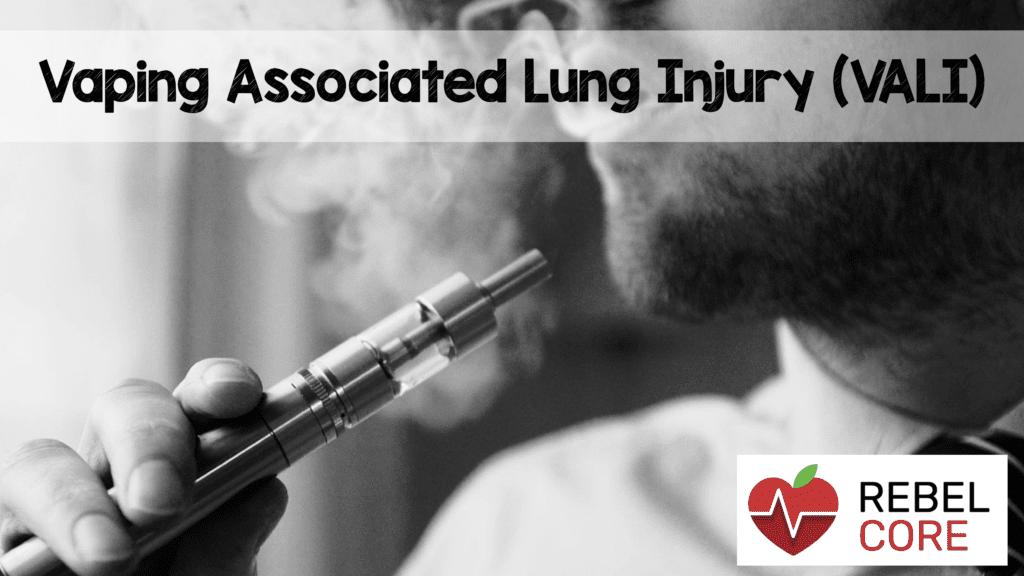 Background: E-cigarettes or “vapes” are now the most popular tobacco product among US teens and are used by 20% of all high-schoolers2. Vapes are used to heat and vaporize a liquid (e-juice or vape juice) that may contain nicotine, tetrahydrocannabinol (THC), cannabidiol (CBD), or ultraconcentrated THC resin (hash oil, wax, or dabs.)3.
Background: E-cigarettes or “vapes” are now the most popular tobacco product among US teens and are used by 20% of all high-schoolers2. Vapes are used to heat and vaporize a liquid (e-juice or vape juice) that may contain nicotine, tetrahydrocannabinol (THC), cannabidiol (CBD), or ultraconcentrated THC resin (hash oil, wax, or dabs.)3.
Since their introduction, vaping devices have been studied for the numerous potentially harmful chemicals they can introduce into users, including: heavy metals (cadmium, nickel, lead), plastic-related toxic gases (like cyanide and phosgene), volatile organic compounds, ultrafine particles, and diacetyl flavoring (linked to a chronic pulmonary syndrome known as ‘popcorn lung,’ which is not as appealing as it sounds)4.
More recently, a spectrum of lung illnesses related to vaping have become the focus of a national public health investigation. These cases have been described in almost every US state since early summer 2019; as of November 2019, there have been over 2000 cases of ‘Vaping-Associated Lung Injury’ (VALI) reported to the CDC, with 42 associated deaths.
The article discussed below is a large case series from the Midwest depicting the clinical characteristics and outcomes of patients with VALI from April to August 2019. Since then, several more epidemiological and analytical investigations have been published, and studies are ongoing to clarify the causes and best treatments for this disorder. We chose this article for REBEL EM because it represents a well-done early investigation of an emerging epidemic which contributed valuable clinical insights for emergency medicine practice.
What They Did:
- Multi center, retrospective case-series + interviews of case patients
- The departments of health in the states of Wisconsin and Illinois issued health alerts beginning July 2019, requesting that providers report cases of vaping associated pulmonary disease.
Authors:
- Evaluated reported cases from April-August 2019 meeting the definition of VALI, establishing a case cluster
- Established a baseline rate of severe, unexplained respiratory illness via a surveillance tool by scanning data from all ED visits January 2018 – August 15, 2019 in counties in Illinois where cases had been identified.
- Compared April – August 2019 cluster to estimated baseline rate
- Provided CT images and a case report on a single, representative case
With the Goal Of:
- Providing descriptive data on cases which meet VALI definition
- Determining whether the April-August 2019 cluster of VALI cases represent an increase from baseline rate of unexplained respiratory illness
Case Definition:
- A case-definition for VALI was established:
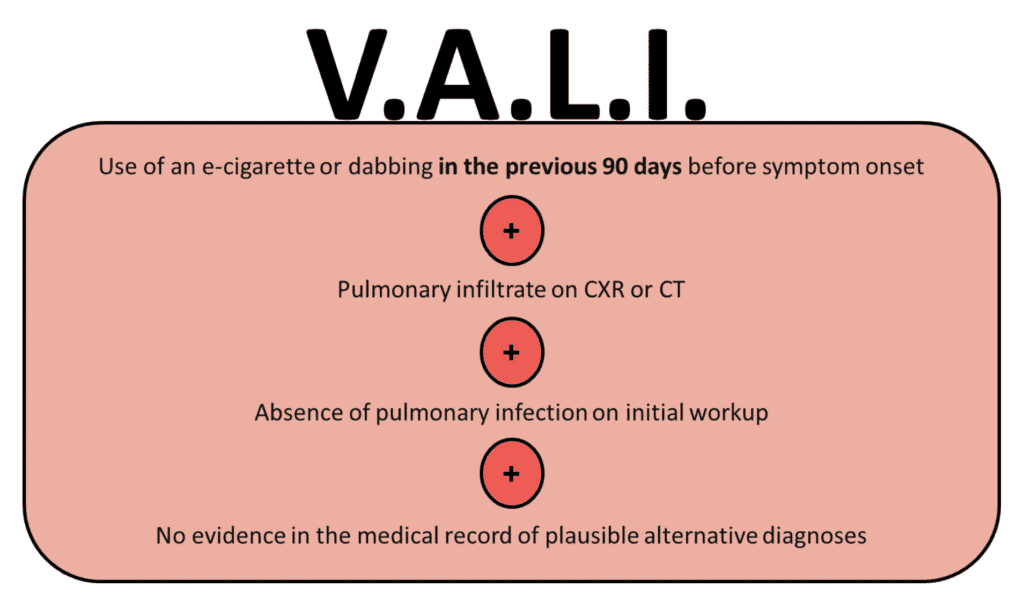
Results:
- 28 cases met the definition of a confirmed case
- 25 cases met the definition for a probable case
-
14 distinct brands of THC products and 13 brands of nicotine products, in different flavors.
The most common product was marketed as ‘Dank Vape’ (59%).
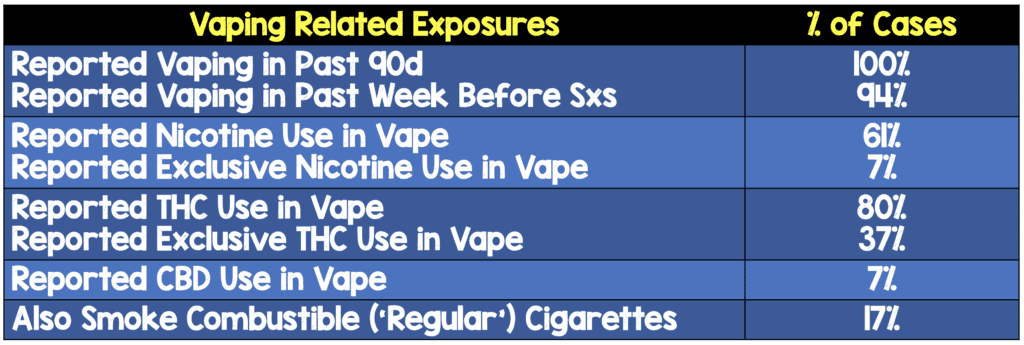
Imaging Findings:
- 48/53 patients underwent CT
- 100% of these had abnormal findings:
- 48 had opacities in both lungs
- 4 had pneumomediastinum
- 5 had pleural effusions
- 1 had pneumothorax
Syndromic Surveillance:
- Mean monthly visits to ED for respiratory illness June 1-August 15, 2019 was twice the monthly rate that occurred between the same dates in 2018.
Case Report and Representative Radiographs:
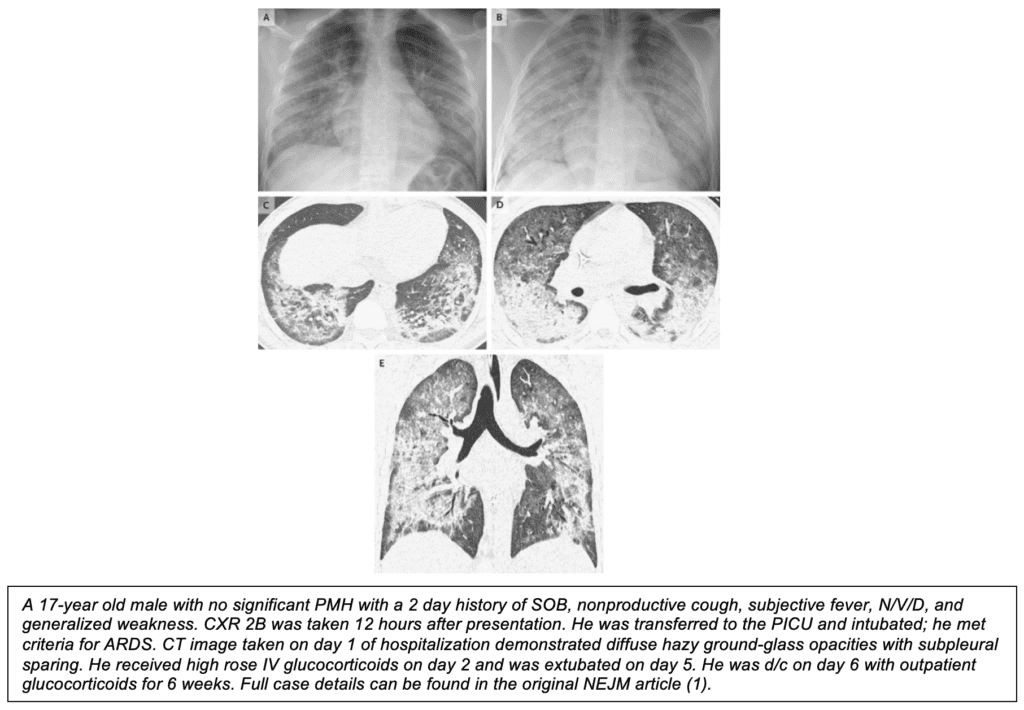
Strengths:
- First cluster identified within a large catchment zone
- Retrospective chart review identified treatment, course, disposition, and outcome
- Interviews with cases determined exact exposures
- For the first time, provided a strict case definition of VALI, including a comprehensive negative infectious workup
Limitations:
- Under-Reporting: Surveillance studies are limited by under-reporting, particularly as patients may not be routinely asked about vaping exposures.
- Conversely, reporter bias and over-classification of cases as VALI may stem from hyper-representation of VALI in national media
- Exposure misclassification: exact nature of exposure remains unknown; many have likely been vaping for years and likely don’t exclusively smoke one brand or type. In Wisconsin and Illinois, marijuana use is illegal; patients have incentive to under-report criminalized drug use.
- Low n; ultimately only 28 instances met definitions of a confirmed case. Given high rate of exposure (20% of high school students vape), additional reports with larger sample size may offer more conclusive data
- Association not demonstrated: retrospective observational study has low potential to identify association between exposure and disease. More robust study designs include case-control.
Discussion:
Vape-related injury has been described for years by case reports5-11. The clinical syndrome known as VALI may simply represent a new manifestation of vape-related injury. The earlier cases described illness patterns which are not explained by the active components themselves (e.g. nicotine or THC). A common theme is that there are multiple pathological and radiographic patterns found in patients who have vaping-related lung illness, and that there are many devices and substances implicated.
In this article, surveillance of two states during April-August 2019 revealed 53 cases which met definitions of VALI. Patients were seriously ill, with about a third requiring intubation and ICU admission and with one documented death. All cases demonstrated CT abnormalities with bilateral opacities. A large majority of cases (80%) reported using THC in vapes, which is consistent with other series of VALI patients12.
Another interesting aspect of this study is the reported efficacy of glucocorticoids; 65% of patients who received systemic glucocorticoids had “documentation by the clinical team that respiratory improvement was due to the use of glucocorticoids.” The CDC has provided recommendations for physicians, which include initiating glucocorticoids when appropriate, but more rigorous study is needed to define which populations benefit most and the doses and durations needed.
In recent weeks, since the publication of the article discussed above, the CDC and FDA have released additional information about the risk factors and “chemicals of concern” associated with VALI. Patients with VALI had higher odds of using only THC-containing products, obtaining them through informal sources (like friends or relatives), and using a counterfeit THC-containing product13. In another study, the BAL fluid obtained from 29 patients demonstrated the presence of vitamin E acetate, a thickening agent used in THC-containing vape juice, in all samples tested14. However, these trends do not explain all described cases of VALI that have been reported since spring of 2019, and more studies are needed to understand why VALI develops in some patients versus others. Lastly, despite advances in the understanding of this illness, there is a lot about the optimal treatment for this disorder that remains unknown, and standardized treatment guidelines have not been published at the time of this writing.
Clinical Take Home Point: Patients who vape are at risk for developing VALI, especially if they use THC-containing vapes. However, no single product or ingredient has been definitively implicated in VALI. New data continues to emerge daily.
Treatment centers on supplemental O2, bronchodilators, steroids, ruling out infectious causes, and abstinence from vaping and smoking.
Reporting all suspected or confirmed VALI cases to local public health departments can help better define the epidemiology and natural history of this illness.
Guest Post By:
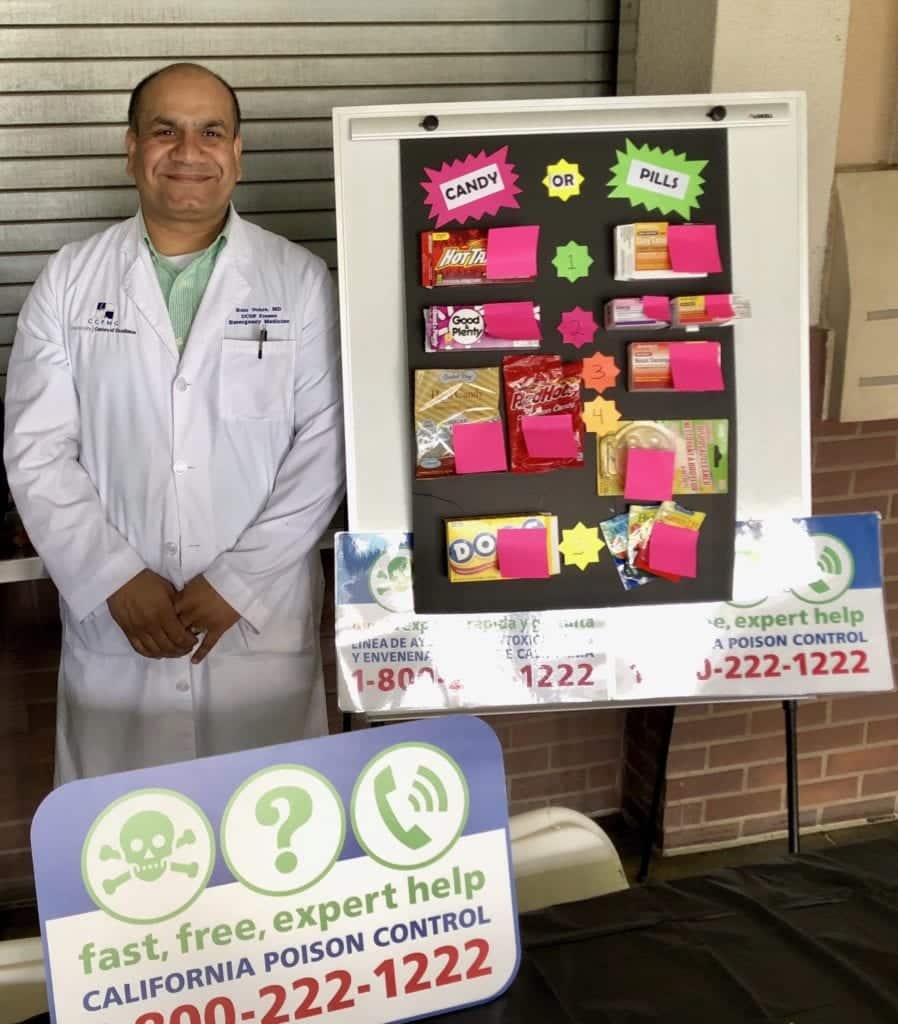
AND

To Learn More About this Topic, we Suggest:
- Perrine CG et al. Characteristics of a Multistage Outbreak of Lung Injury Associated with E-Cigarette Use, or Vaping — United States, 2019. Morbidity and Mortality Weekly Report, 68 (39), 860. [Link is HERE]
- Lewis N et al. E-Cigarette Use, Vaping , Practices and Characteristics Among Persons With Associated Lung Injury – Utah, April – Oct 2019. Morbidity and Mortality Weekly Report, 68.42 (2019): 953. [Link is HERE]
References:
- Layden, J.E., et al. Pulmonary illness related to e-cigarette use in Illinois and Wisconsin—preliminary report. New England journal of medicine 2019.PMID: 31491072.
- Cullen K et al. e-Cigarette Use Among Youth in the United States, 2019. JAMA. 2019 PMID: 31688912.
- Breitbarth, A.K., Morgan, J. & Jones, A.L. E-cigarettes—an unintended illicit drug delivery system. Drug and alcohol dependence2018. PMID: 30245461.
- Farsalinos, K., Voudris, V. & Poulas, K. Are metals emitted from electronic cigarettes a reason for health concern? A risk-assessment analysis of currently available literature. International journal of environmental research and public health2015. PMID: 25988311.
- Sommerfeld, C.G., Weiner, D.J., Nowalk, A. & Larkin, A. Hypersensitivity pneumonitis and acute respiratory distress syndrome from e-cigarette use. PMID: 29773665
- Arter, Z.L., et al. Acute eosinophilic pneumonia following electronic cigarette use. Respiratory medicine case reports2019. PMID: 30963023
- Thota, D. & Latham, E. Case report of electronic cigarettes possibly associated with eosinophilic pneumonitis in a previously healthy active-duty sailor. The Journal of emergency medicine2014. PMID: 24462024
- Moore, K., Henry Young, I. & Ryan, M.F. Bilateral pneumonia and pleural effusions subsequent to electronic cigarette use. Open Journal of Emergency Medicine 2015. Available
- Khan, M.S., et al. Organizing pneumonia related to electronic cigarette use: A case report and review of literature. The clinical respiratory journal2018. PMID: 29392888
- Anderson, R.P. & Zechar, K. Lung injury from inhaling butane hash oil mimics pneumonia. Respiratory medicine case reports2019. PMID: 30671339.
- He, T., Oks, M., Esposito, M., Steinberg, H. & Makaryus, M. “Tree-in-Bloom”: severe acute lung injury induced by vaping cannabis oil. Annals of the American Thoracic Society 2017. PMID: 28248584
- Perrine, C.G., et al. Characteristics of a multistate outbreak of lung injury associated with e-cigarette use, or vaping—United States, 2019. Morbidity and Mortality Weekly Report2019.PMID: 31581168.
- Navon L, Jones CM, Ghinai I, et al. Risk Factors for E-Cigarette, or Vaping, Product Use–Associated Lung Injury (EVALI) Among Adults Who Use E-Cigarette, or Vaping, Products — Illinois, July–October 2019. MMWR 2019. PMID: 31725708.
- Blount BC, Karwowski MP, Morel-Espinosa M, et al. Evaluation of Bronchoalveolar Lavage Fluid from Patients in an Outbreak of E-cigarette, or Vaping, Product Use–Associated Lung Injury — 10 States, August–October 2019. MMWR 2019. PMID: 31725707.
Post Peer Reviewed By: Salim R. Rezaie, MD (Twitter: @srrezaie) & Anand Swaminathan, MD (@EMSwami)
Image Credit from Flickr
The post Vaping Associated Lung Injury (VALI) appeared first on REBEL EM - Emergency Medicine Blog.
